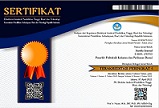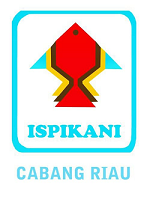CHITOSAN PRODUCTION FROM SQUID BONE Loligo. Sp WITH DIFFERENT CONCENTRATIONS OF SODIUM HYDROXIDE
Abstract
Keywords
Full Text:
PDFReferences
Anicuta, S., Dobre, L., Stroescu, M., & Jipa, I. (2010). Fourier transform infrared (ftir) spectroscopy for characterization of antimicrobial films containing chitosan. Analele Universitatii Din Oradea Fascicula: Ecotoxicologie, Zootehnie Si Tehnologii de Industrie Alimentara, 1234–1240.
Annisaq, N. (2020). Pembuatan Kitosan Dari Kitin Dari Limbah Tulang Dalam Cumi-Cumi Making Chitosan from Chitin From Bone Waste in Squid. 6(1), 62–69.
Aranaz, I., Acosta, N., Civera, C., Elorza, B., Mingo, J., Castro, C., Gandía, M. de los L., & Caballero, A. H. (2018). Cosmetics and cosmeceutical applications of chitin, chitosan and their derivatives. Polymers, 10(2). https://doi.org/10.3390/polym10020213.
Aranaz, I., Alcántara, A. R., Civera, M. C., Arias, C., Elorza, B., Caballero, A. H., & Acosta, N. (2021). Chitosan: An overview of its properties and applications. Polymers, 13(19). https://doi.org/10.3390/polym13193256.
Bayu, A., Nandiyanto, D., Oktiani, R., & Ragadhita, R. (2019). Indonesian Journal of Science & Technology How to Read and Interpret FTIR Spectroscope of Organic Material. 1, 97–118.
Badan Standarisasi Nasional [BSN]. (2013). Stadar Mutu Kitosan SNI No. 7949: 2013. Jakarta (ID).
Dahmane, E. M., Taourirte, M., Eladlani, N., & Rhazi, M. (2014). Extraction and Characterization of Chitin and Chitosan from Parapenaeus longirostris from Moroccan Local Sources. International Journal of Polymer Analysis and Characterization, 19(4), 342–351. https://doi.org/10.1080/1023666X.2014.902577.
Dompeipen, E. J., Kaimudin, M., & Dewa, R. P. (2016). Isolasi Kitin Dan Kitosan Dari Limbah Kulit Udang Isolation. Majalah BIAM, 12(1), 32–38. http://ejournal.kemenperin.go.id/bpbiam/article/view/2326.
Henggu, K. U. (2021). Morphological characteristics and chemical composition of Cuttlebone (Sepia sp.) at Muara Angke fishing port, Jakarta Indonesia. IOP Conference Series: Earth and Environmental Science, 718(1). https://doi.org/10.1088/1755-1315/718/1/012034.
Hossain, M. S., & Iqbal, A. (2014). Production and characterization of chitosan from shrimp waste. J. Bangladesh Agril. Univ, 12(1), 153–160.
Huang, Y. L., & Tsai, Y. H. (2020). Extraction of chitosan from squid pen waste by high hydrostatic pressure: Effects on physicochemical properties and antioxidant activities of chitosan. International Journal of Biological Macromolecules, 160, 677–687. https://doi.org/10.1016/j.ijbiomac.2020.05.252.
Joseph, S. M., Krishnamoorthy, S., Paranthaman, R., Moses, J. A., & Anandharamakrishnan, C. (2021). A review on source-specific chemistry, functionality, and applications of chitin and chitosan. Carbohydrate Polymer Technologies and Applications, 2(January), 100036. https://doi.org/10.1016/j.carpta.2021.100036.
Kamran, U., & Park, S. J. (2020). Tuning ratios of KOH and NaOH on acetic acid-mediated chitosan-based porous carbons for improving their textural features and CO2 uptakes. Journal of CO2 Utilization. 101212. https://doi.org/10.1016/j.jcou.2020.101212.
Manigandan, V., Karthik, R., Ramachandran, S., & Rajagopal, S. (2018). Chitosan Applications in Food Industry. In Biopolymers for Food Design (Issue 2002). Elsevier Inc. https://doi.org/10.1016/B978-0-12-811449-0.00015-3.
Messerli, M. A., Raihan, M. J., Kobylkevich, B. M., Benson, A. C., Bruening, K. S., Shribak, M., Rosenthal, J. J. C., & Sohn, J. J. (2019). Construction and composition of the squid pen from doryteuthis pealeii. Biological Bulletin, 237(1), 1–15. https://doi.org/10.1086/704209.
Pellis, A., Guebitz, G. M., & Nyanhongo, G. S. (2022). Chitosan: Sources, Processing and Modification Techniques. Gels, 8(7), 5–25. https://doi.org/10.3390/gels8070393.
Rahmawati, H., & Iskandar, D. (2014). Sitesis karboksimetil kitosan . Jurnal Kimia. 6 (2): 1979-8415
Ramya, R., Venkatesan, J., Kim, S. K., & Sudha, P. N. (2012). Biomedical Applications of Chitosan : An Overview. 2(2). https://doi.org/10.1166/jbt.2012.1030.
Rochima, E. (2007). Karakterisasi kitin dan kitosan asal limbah rajungan cirebon jawa barat. X, 9–22.
Rochima, E., Syah, S. D., & Suhartono, M. T. (2004). Derajat Deasetilasi Kitosan Hasil Reaksi Enzimatis Kitin Deasetilase Isolat Bacillus papandayan K29-14.
Rochmawati, Z. N., Nabila, F., & Ainurrohmah, C. (2015). KARAKTERISASI KITOSAN YANG DIISOLASI DARI CANGKANG INTERNAL CUMI-CUMI.
Siregar, E. C., & Hakim, L. (2016). Jurnal Teknologi Kimia Unimal PEMBUATAN KITOSAN DARI TULANG SOTONG. 2(November), 37–44.
Swiatkiewicz, S., Swiatkiewicz, M., & Jozefiak, D. (2015). Chitosan and its oligosaccharide derivatives ( chito-oligosaccharides ) as feed supplements in poultry and swine nutrition. 99, 1–12. https://doi.org/10.1111/jpn.12222
Umbu Henggu, K., Lapu, R. U., Takanjanji, P., Fretty, R., Djawa, N., Lingga, S. R., Abbas, S., Ngunju, H. H., Willy, I. R., & Nalu, N. T. (2022). Modifikasi Kitosan Dari Limbah Cangkang Kepiting Sebagai Sediaan Material Membran Filtrasi Air. Jambura Fish Processing Journal, 4(2), 72–82. http://ejurnal.ung.ac.id/index.php/jfpj/issue/archive.
Umemura, K., & Kawai, S. (2007). Modification of chitosan by the Maillard reaction using cellulose model compounds. 68, 242–248. https://doi.org/10.1016/j.carbpol.2006.12.014.
Yusharani, M. S., Stenley, Harmami, Ulfin, I., & Ni’Mah, Y. L. (2019). Synthesis of water-soluble chitosan from squid pens waste as raw material for capsule shell: Temperature deacetylation and reaction time. IOP Conference Series: Materials Science and Engineering, 509(1). https://doi.org/10.1088/1757-899X/509/1/012070.
DOI: http://dx.doi.org/10.15578/aj.v5i1.11538
Refbacks
- There are currently no refbacks.
Citation
Pusat Penelitian dan Pengabdian Kepada Masyarakat
Politeknik Kelautan dan Perikanan Dumai
Jl. Wan Amir No. 1, Kel. Pangkalan Sesai, Kec. Dumai Barat, Kota Dumai
Telp/Fax: (0765) 4300443
This work is licensed under a Creative Commons Attribution-ShareAlike 4.0 International License.
View My Stats















